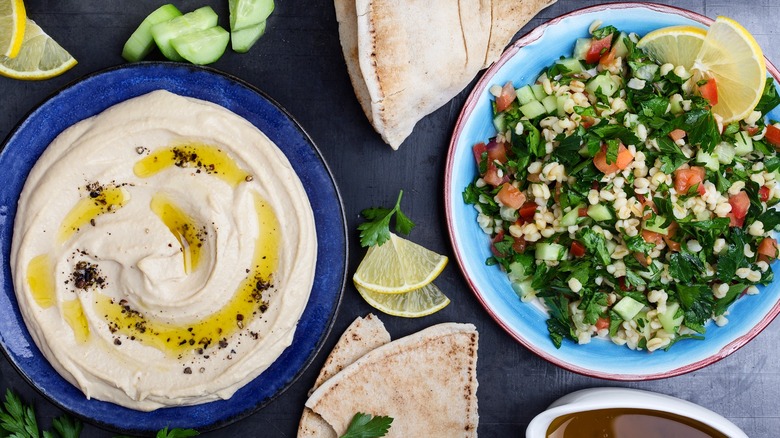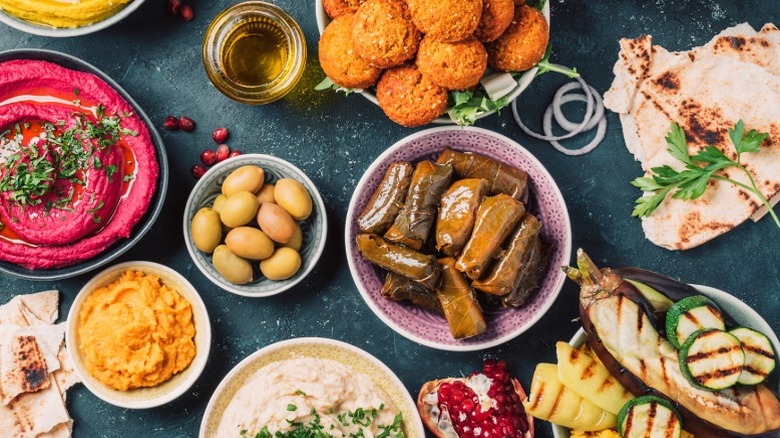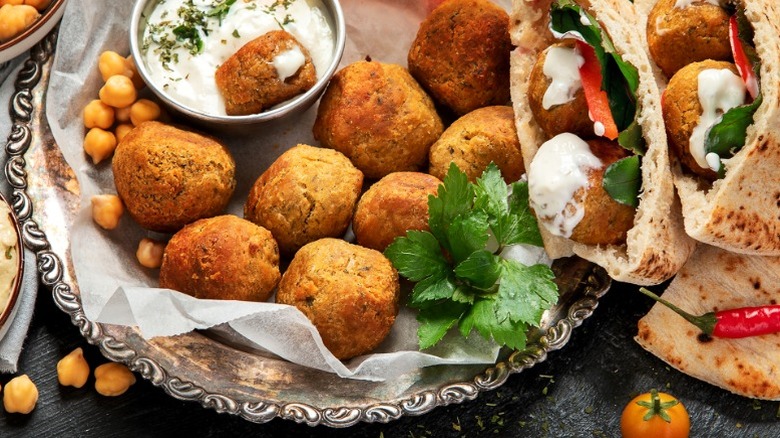What's The Difference Between Mediterranean And Middle Eastern Cuisine?
Mediterranean and Middle Eastern cuisines share many similarities — the main one being that they're both delicious — but there are some distinctions as well. Each region has a specific geographic position that impacts what kinds of ingredients are available through historical weather and trade patterns. For instance, Italian eggplant parmesan is Mediterranean, Iranian chelo kebab is Middle Eastern, and Palestinian msakhan is — to some degree — a bit of both. Mediterranean cuisine is characterized by the areas around the Mediterranean Sea, which may include European, Middle Eastern, and North African countries. The Middle East is a geographical area east of Europe and west of central Asia, including some landlocked countries with hotter and drier climates.
Chowhound spoke with Wissam Baki, the executive chef at Miami's AMAL, for some perspective on these two cuisines. As an expert in cooking Lebanese food, he notes that Mediterranean and Middle Eastern cuisines can share common ingredients and cooking techniques, but the flavor profiles and seasoning are where things start to change. The flavors in Middle Eastern cuisine tend to be bolder and spicier, while Mediterranean cuisine features significantly lighter flavors.
"Middle Eastern cuisine is well known for its blend ... and use of over 50 different spices," Baki says. "Seven common spices include sumac, cumin, turmeric, coriander, cardamom, and herbs like rosemary. Mediterranean cuisine tends to use herbs like rosemary, oregano, thyme, and basil."
Where Middle Eastern and Mediterranean cuisines overlap
The Mediterranean and Middle Eastern cuisines prioritize quality ingredients, including olive oil, herbs, grains, fresh produce, and seafood — things we might find at a Middle Eastern grocery store. The areas closer to the seas have better land for farming, so plenty of people grow and make their own food, as one neighbor might have fennel to trade for oranges, and another might have some extra olives from their tree to give. This routine also means receiving ingredients when they're in season.
Sharing extends beyond the farming and right down to the dining. A mezze platter is a type of bite-sized feast popular in both Middle Eastern and Mediterranean cuisine, where people can sample several homemade dishes in a single event. Fluffy blended hummus, crispy falafel, and grape leaf dolmas could all sit together at the table, with each diner experiencing a bit of everything. As Chef Wissam Baki says, "Both [Middle Eastern and Mediterranean] cuisines emphasize the importance of a shared meal and shared communal dining with dishes often designed to be shared among family [and] friends for gatherings and parties."
Celebrating food diversity across cuisines
Focusing on similarities between food cultures can bring people together in a beautiful way, but if variety is the spice of life, then differences can be celebrated as well. Chowhound spoke with another expert, Jilbert El-Zmetr, the founding chef of Laziza, about these similarities and distinctions. He brings a taste of Lebanon, Turkey, Iran, and more to the streets of Brooklyn, New York, through his restaurant.
"Let's be controversial here, but after 9/11, many Middle Eastern spots started changing their identity to Mediterranean to avoid the bias associated with the events that took place," El-Zmetr says, noting, as well, that this was particularly unfortunate as the Middle East is far from being limited to countries bordering the Mediterranean Sea. "From Far West Asia all the way to the Northeastern borders of Iran and Asia Minor, Middle Eastern cuisine has so many influential ports of call that we need to celebrate — not only their common links, but also the diversity."
Middle Eastern and Mediterranean food both cover a large and ever-evolving landscape with talented cooks combining ancient traditional knowledge with their own modern flair. From fattoush salad to loaded ground beef gyro sandwiches, there's surely something to delight your palate. Now, who else is getting hungry?


